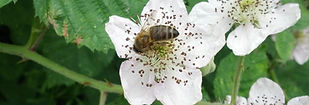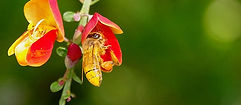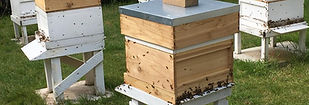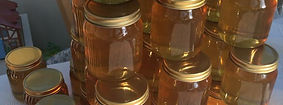top of page






Norwich & District Beekeepers Association
Helping Beekeepers and Honey Bees for over 15 Years

Asian Hornet Awareness Training
Identify & Report Asian Hornet
1, Does it look very black?
2, Has it got a wide orange stripe on 4th segment of abdomen?
3, Does its legs look as if they have been dipped in yellow paint


Copyright - Somerset Beekeepers Assoc 2024
Image by David Walker and used courtesy of NBU

The Asian hornet looks like a large black wasp with a bright orange face. Photo courtesy of Jean Haxaire, The French Natural History Museum

The European hornet is more like a large wasp with bright yellow stripes. Photo courtesy of Jason Learner, National Bee Unit

The Asian hornet nest discovered low down in a hedge in North Devon in September 2017
All the above information has been kindly supplied by the Somerset Beekeepers Association
Asian hornets (Vespa velutina nigrithorax) cause significant environmental damage and sightings should be reported to the Non-Native Species Secretariat (NNSS) as soon as you can.
-
Asian hornets are most active between April and November (peaking in August/September) and are inactive over the winter.
-
If they get established in the UK it is predicted they will have a devastating impact on our insect population and ecosystem.
-
A number of sightings have been recorded in the UK since the first was spotted in 2016 and we fear numbers will inevitably increase.
-
In Jersey, France and large areas of Western Europe they are stripping the environment bare of insects including managed honeybee colonies.
What can you do?
Monitor for Asian hornets this Autumn.
-
Download the Asian hornet app which has photos to assist with identification and can be used to report any sightings:
Asian Hornet Watch app for iPhone
Asian Hornet Watch app for Android
-
Or report using an online form.
-
If you have connections with local gardening groups, garden centres, wildlife groups and trusts etc, please spread the word.
-
The Non Native Species Secretariat provides a series of resources free of charge including posters and identification sheets which you can distribute to others. Our suite of ID resources is available to download for use at beekeeper and public events.
If you spot an Asian hornet
Take some photos and/or capture a specimen and send them to the NNSS for identification; if the sighting is positive, the NNSS will trigger further investigations by our bee inspectors.
Fera Science has released the following education/training videos:
Asian hornet Biology
Asian hornet Genetics
And we have made the artwork for our Asian hornet resources - banners, leaflets, ID cards & stickers etc available for anyone to use.
What do they look like?
Asian hornets are rather like large black wasps with a single yellow band, orange face and yellow tipped legs. Queens are up to 30mm long, workers up to 25mm.
Look out for:
-
black thorax
-
abdomen mostly black except for an orange fourth segment
-
legs brown with yellow ends
-
head black with orange-yellow face
-
Queens buzz quite deeply, like a bumblebee
How to detect Asian hornets
The NBU recommends DIY traps; alternatively traps are available to purchase from beekeeper equipment suppliers.
It's recommended that you observe activity carefully around your hives especially in the autumn.
The National Bee Unit has added a new feature to BeeBase to help understand UK Asian hornet surveillance.
Download the Asian hornet app which has photos to assist with identification and can be used to report any sightings:
And, of course, if you spot a nest don't try and destroy it yourself. Alert the authorities!
Likely habitat?
Asian hornets are easiest to see around flowers and bee hives in late summer and early autumn. Nests can be high up in deciduous trees, in hedges and in buildings.

bottom of page

